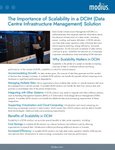Like many industries, data centers experienced the economic and operational strain of global supply chain issues during the Covid-19 pandemic.
While pundits have declared supply chains close to pre-pandemic normalcy, data centers still feel the heat of supply chain delays and disruptions.
In fact, research from Uptime Institute found that troubles in the data center supply chain worsened from March 2022 to March 2023, with a 60 percent increase in operators experiencing procurement issues.
The availability of parts remains the most significant pain point for data centers. But now, instead of only experiencing shipping disruptions that increase the time between orders and delivery, data centers are encountering the repercussions of delayed maintenance during the pandemic.
Data centers are critical infrastructure for our digital world. Upkeep and upgrades to data centers ensure our information is secure and our devices work correctly.
Still, maintenance cannot occur if data centers are affected by supply chain issues. OEMs must understand the causes and effects of supply chain delays.
Shipping delays persist
The most prominent impact of the pandemic on supply chains is shipping delays. While the data center industry agrees longer lead times for spare or just-in-time parts are improving, global shipping logistics are susceptible to many disruptions, often out of the supply chain’s hands.
Severe weather can impact parts production and disrupt plane, shipping, and cargo routes.
Political conflict in South America and Ukraine limits raw material availability and causes port congestion.
So, while pandemic-era difficulties like labor shortages have subsided, geo-political factors still affect shipping times, especially for OEMs with global footprints.
Impact of aging equipment
Amid economic uncertainty and supply chain issues, many data centers slowed their maintenance efforts and transformational projects during the pandemic. According to Uptime, the average time between data center refreshes lengthened during Covid-19, with a five-year lifecycle becoming the new normal.
While this might raise a red flag for data center purists who believe in monthly or even weekly equipment maintenance, many data centers found that holding out on updates didn’t cause detrimental disruptions to their operations, allowing them to get more out of their aging equipment. Yet that stopgap approach is now catching up with data centers.
As their lengthened life begins to sputter, aged assets now need significant maintenance and updating.
However, because data centers decommissioned fewer assets over the pandemic, procurers have fewer recycled parts. Drives, power supplies, and blades that multi-vendor services once sourced from decommissioned equipment are unavailable globally, and data centers cannot carry out critical maintenance of aged equipment still in operation.
Still, difficulty begets innovation. Despite parts shortages, we’re seeing data centers move maintenance and transformation projects forward.
Data centers must adopt proactive servicing techniques to keep maintenance stable and reduce the effects of multi-year supply chain disruptions.
Using predictive analytics within the supply chain
Data centers can expect to feel the effects of shipping delays and unavailable parts for the foreseeable future.
To overcome these difficulties, OEMs must move from a just-in-time mindset to using predictive analytics to anticipate maintenance needs.
Predictive analytics have grown in popularity through the digital transformation. With machine learning and AI, data centers can harness years of information from their operations, along with OEM-published data, to create predictive models for failure rates and maintenance opportunities.
For example, an MVS can use predictive modeling to determine the failure rate of a data center’s drive.
The model finds the likelihood of failure in the next six, 12, or 18 months, informing operators when to order the spare parts before required maintenance.
Using predictive analytics for data center maintenance will grow in popularity. As supply chain issues persist, getting ahead of maintenance is valuable for squeezing more efficiency out of data center spend.
Instead of using a generic model or waiting for asset failure, data centers can use automated modeling unique to their assets, improving maintenance efficiency and keeping equipment running in times of highest demand.






